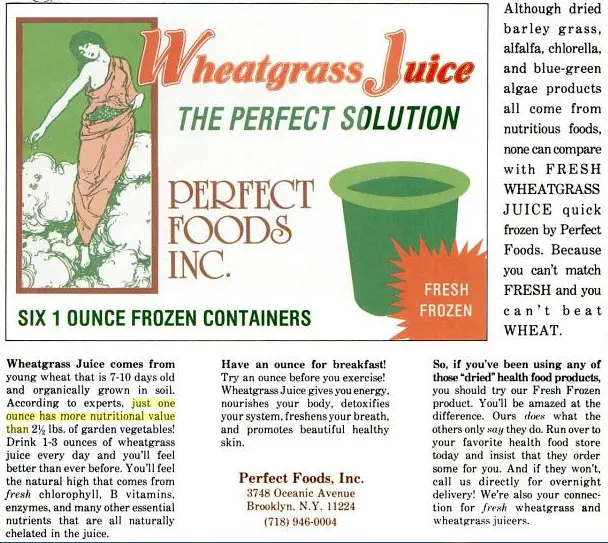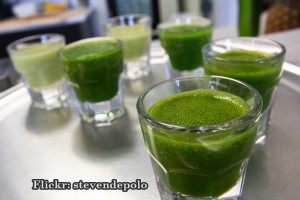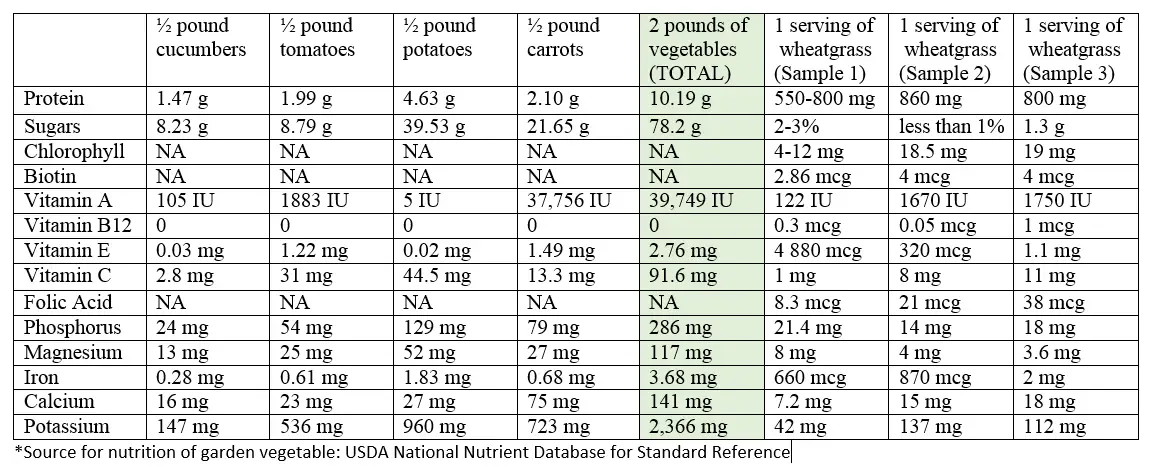As wheatgrass juice became popular, many sources started to claim that one shot or 1 ounce of wheatgrass juice is nutritionally equivalent to about 2-2.5 pounds of vegetables (some even go as high as 4 pounds). Where did this claim come from?
In 1940s Agricultural Chemist Charles Franklin Schnabel studied the effects of wheatgrass on the health of humans and livestock and was so impressed with the results that he started spreading the word about the nutritional wonders of the plant to feed mills and the food industry. While the whole story of Schnabel is much longer (it can be read here), there was one statement that he made about the nutrition in wheatgrass that sounded so impressive that it has not been forgotten, and has been repeated so many times over in the natural health movement that most simply accept it as fact.
Schnabel claimed that “fifteen pounds of wheatgrass is equal in overall nutritional value to 350 pounds of ordinary garden vegetables,” according to the book Wheatgrass: Nature’s Finest Medicine: The Complete Guide to Using Grass Foods & Juices to Revitalize Your Health by Steve Meyerowitz. Schnabel compared it to “ordinary garden vegetables” of the time.

According to recipes about 25 grams of wheatgrass is needed for one 1-2 ounce serving of wheatgrass juice. Using that as our reference, 15 pounds of wheatgrass would give us about 272 servings of wheatgrass. One serving would then be equal to about 1.28 pounds of vegetables according to Schnabel’s math. Since some grass will be juicier than the others depending on the type and environmental differences, to say that 1 ounce would in other measurements translate to about 2 pounds of vegetables is somewhat close, but doesn’t quite measure up.
So, how nutritious is wheat grass really?
Nutrition in Wheatgrass
The nutritional chart that I found being quoted the most by different sources is from Meyerowitz’s book. (The book says the juice was tested at Irvine Analytical Labs in Irvine, California). The other two sources I found were from Cereal Grass: What’s in it for you!, a book edited by Rural Sociologist Ronald L. Seibold, M.S. (sample analyzed by Nutritional International laboratory in East Brunswick, NJ in 1989) and WheatGrass.com; both sources are by PINES International, Inc., wheatgrass supplement producing company, and are discussed later.
Why do the nutritional results vary?
Meyerowitz noted that when measuring the nutrients in any plant material, the numbers will often be different based on many natural variables (ex. How much sunlight did the plant get? Was it growing in healthy soil? Was the plan strong or weak [wild plants are generally stronger than ones from big farms, etc.]?)
Seibold agreed as well that what makes a nutritional difference are the environmental factors: quality of the soil (temperature and moisture play a big role) and health of the seeds, as well as at which stage the grass was gathered. While the growing and harvesting process makes a huge difference, Seibold argued that the type of grass used does not. In Cereal Grass: What’s in it for you! (written and edited for PINES), he referenced more than 150 scientific articles and books and based on this research concluded that there is very little difference in nutritional values between different types of grasses, be it wheat, rye or barley (although different plants do have unique properties in general). He strongly advocated using young grass for its health benefits no matter the type.
Schnabel has said that grass’s high nutritional value at early stages of the plant developed as an evolutionary trait. Because grass is not out of reach for any animal, if the young grass is eaten, it has high energy to regrow itself promptly, according to Seibold’s book. Seibold wrote that the grass’s nutritional peak is just before the jolting stage (the stage “at which the internodal tissue in the grass leaf begins to elongate, forming a stem”) and it lasted just a few days. The plant must be gathered at that precise time to receive the full benefits – the highest chlorophyll and vitamin content.
Another difference Seibold wrote is that nutritional numbers vary between the plants that are grown indoors and the plants that are outdoors and are being exposed to different seasons. The wheatgrass grown at home, he argued, is just not the same.
***
Click Here to Buy Organic Wheatgrass
Available in powder and capsule form
This is the wheatgrass I recommend find it here
***
Wheatgrass Grown in Containers at Home
In his book, Seibold argued that the sprouted wheatgrass that so many are growing at home is just a “grass-like plant.” (Of course, we have to keep in mind that he was writing for PINES with the goal of advertising their product when analyzing this information). If the book’s findings are correct and not exaggerated based on company’s marketing goal, this is how Seibold explains it.
Seibold wrote that homegrown grass is more like a sprout, it does not have the capabilities to get to the jolting stage and will not absorb the nutrients from the soil as it would outside, so therefore it will not have the same nutritional value. Outdoor wheatgrass converts its simple sugars into complex nutrients when grown in cold weather, something that does not happen to homegrown grass, which is why it is very sweet and may make people nauseous, he wrote. He added that it might be why homegrown grass can be used as a cleansing agent, but the wheatgrass PINES grows (and wheatgrass grown outdoors by people who know what they’re doing as well) is more of a nutritional food that can be consumed in much larger quantities, which is why the company sells it as a daily supplement.
Wheatgrass versus Vegetables
For this calculation, let us take ½ pound each of cucumbers, tomatoes, potatoes, and carrots (making it 2 pounds of ordinary vegetables) and compare them to the three different wheatgrass samples we found.
The numbers do not exactly add up, and many questions linger based on the incomplete and potentially biased information that remains from Schnabel’s original claims. Did he compare cooked vegetables and not raw to wheatgrass? Were carrots not included? Did he simply say that because he wanted to sell his product?
What we do know is that wheatgrass juice does wonders for many. Ann Wigmore opened the Hippocrates Health Institute with wheatgrass used as one of the main treatments. Her story speaks for itself, plus her clients as well as thousands of people across the world are still leaving testimonials about wheatgrass helping with everything from high blood pressure and diabetes to fatigue and anemia, as well as aiding in treating cancer.
Perhaps if the pharmaceutical industry did not interfere right after WWII, the funding for wheatgrass research would not have been cut, and we would have more scientific studies about it today. Scientifically we have seen that wheatgrass improved ulcerative colitis, helped patients with a blood disorder, and reduced myelotoxicity in breast cancer patients.
Perhaps we do not yet fully understand why wheatgrass works and are just one study away from finding it out.
Click Here to Purchase Wheatgrass from an amazing Organic Company – Over 75% Five Star Reviews
Thanks for installing the Bottom of every post plugin by Corey Salzano. Contact me if you need custom WordPress plugins or website design.








